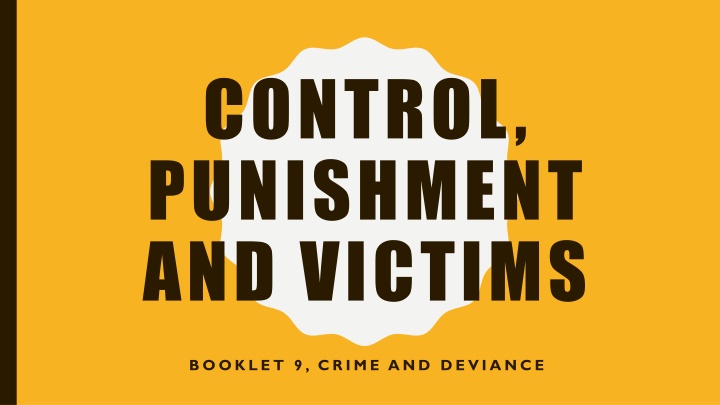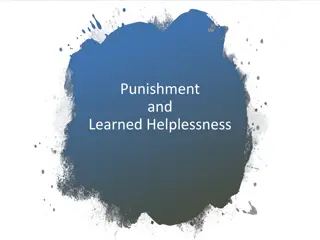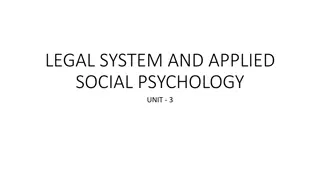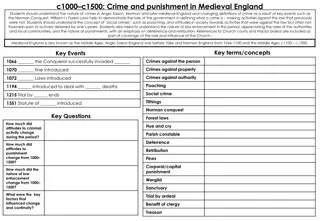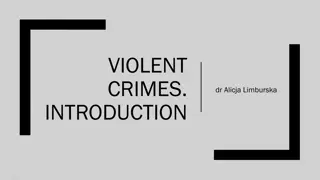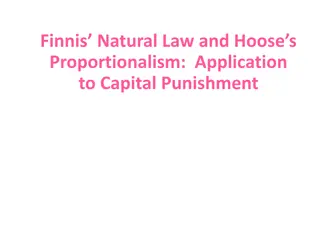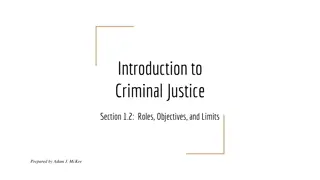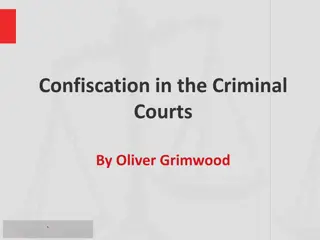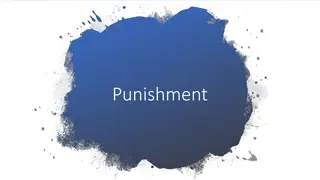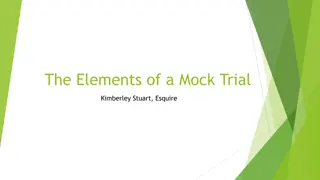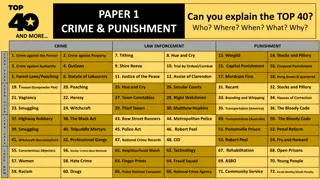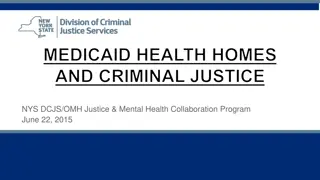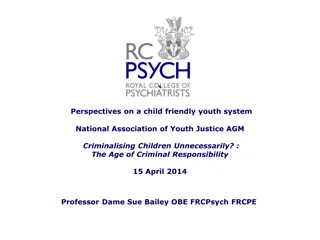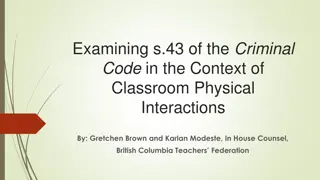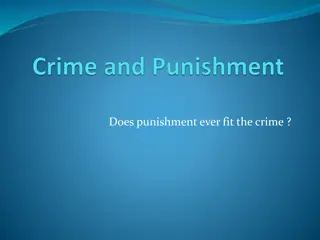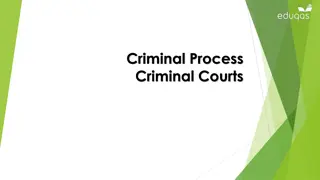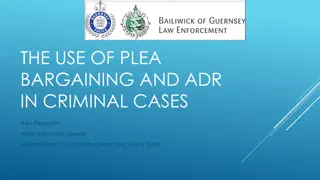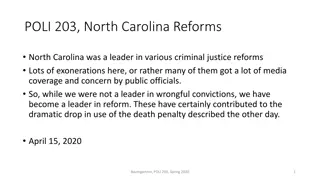Evolution of Punishment: From Brutality to Modern Criminal Justice System
Punishment for crime has evolved over time from brutal public spectacles to more civilized forms of discipline in modern society, reflecting changes in ruling class interests. The Criminal Justice System (CJS) focuses on deterrence, public protection, retribution, and rehabilitation. There has been a shift towards retributive justice and crime prevention, influencing approaches to criminal justice in recent decades.
Download Presentation

Please find below an Image/Link to download the presentation.
The content on the website is provided AS IS for your information and personal use only. It may not be sold, licensed, or shared on other websites without obtaining consent from the author.If you encounter any issues during the download, it is possible that the publisher has removed the file from their server.
You are allowed to download the files provided on this website for personal or commercial use, subject to the condition that they are used lawfully. All files are the property of their respective owners.
The content on the website is provided AS IS for your information and personal use only. It may not be sold, licensed, or shared on other websites without obtaining consent from the author.
E N D
Presentation Transcript
CONTROL, PUNISHMENT AND VICTIMS BOOKLET 9, CRIME AND DEVIANCE
HISTORY OF PUNISHMENT Punishment for crime has changed over time. We ve moved from public spectacles of cruel brutality and the infliction of bodily pain (see the introduction to Foucault s Discipline and Punish , which can be found on Godalming Online) to a more civilised form of punishment that we see in modern society today. Foucault believed brutal punishments were not there to deter people from crime, instead they acted as public demonstrations of the power of the monarch over criminals, including their bodies. As the power of monarchs (sovereign power) declined a new form of state power and control developed over criminals. Foucault referred to this as disciplinary power . Constant, external monitoring became part of this punishment through surveillance the offender would be constantly watched. Rusche and Kirchheimer (1939) as Marxists saw punishment as part of a system of social control and class domination in unequal societies. The way that punishment has changed is due to the changing interests of the ruling class.
THE CRIMINAL JUSTICE SYSTEM (CJS) The CJS refers to all the different agencies and organisations that are involved in law, order, crime and punishment and how they work together. Includes organisations like the police, Crown Prosecution Service (prosecutes criminal cases investigated by the police, courts, prisons and probation service. Overseen by government departments of the Home Office and Ministry of Justice. These agencies are the main means of identifying, controlling and punishing known offenders. This topic will cover how crime can be prevented, how criminals can be punished and who the main victims of crime are.
CJS HAS 4 POINTS OF FOCUS Deterrence: preventing people from committing crime e.g. situational crime prevention, environmental, social and community. Public protection: maintain public order, prevent crime and catch offenders. Retribution: punishing criminals for their wrongdoing. Rehabilitation: alongside or instead of retribution criminals should be helped to be turned into reformed characters.
CHANGING APPROACHES TO CRIMINAL JUSTICE Garland (2001) suggests that in most of the 20thcentury the focus of the CJS was on rehabilitation (reform) of offenders, but that since the 1970s there has been a growing emphasis on retributive justice, with harsher penalties. This was shown by a huge increase in imprisonment, with the number of prisoners in the UK doubling between 1970 and 2014. What could have influenced this? There has also been an increasing focus since the 1980s on preventing crime in the future. What could have influenced this?
FROM LEFT REALISM TO RIGHT REALISM Garland (2001) sees these changes in criminal justice reflected in sociological theory. There has been a shift from Left Realist style theories which focused on the causes of crime rooted in social injustice and inequality, towards a more Right Realist style approach. They have emphasised the need for more social control, stricter socialisation, harsher punishment and measure to reduce the opportunities for criminal acts to be committed. He argues there is now a culture of control , concerned with controlling, preventing and reducing the risks of people becoming victims of crime, rather than rehabilitation.
PUNISHMENT: 1 - REDUCTION One justification for punishing offenders is that it prevents future crime through: Deterrence: punishing people discourages them from future offending and by making an example of someone serves as a deterrence to others e.g. introduction of short times in young offenders institutions in the 1980s. Rehabilitation: reforming or helping to change offenders so that they no longer offend e.g. providing education. Incapacitation: removing the capacity of the offender to offend again e.g. imprisonment, execution, the cutting off of hands.
PUNISHMENT: 2 - RETRIBUTION Means paying back . It is an approach that punishes people for crimes they have already committed, rather than trying to prevent future crimes. It is based on the idea that society should be able to express their displeasure and take their revenge e.g. by offenders having to pay back what they owe to the victim.
THEORIES OF PUNISHMENT Using pp.149-150 of Webb and pp528-529 of Browne make notes on the theoretical approaches of the following theories: Functionalism Marxist Weberian Add evaluation points for each.
DOES PRISON WORK? Use p.529 of Browne (2015) to make notes in your booklet on whether imprisonment prevents crime.
CONTROL APPROACHES
SURVEILLANCE Surveillance can be defined as the monitoring of public behaviour for the purposes of population and crime control. It therefore involves observing people s behaviour to gather data about it, and typically using the data to regulate, manage or correct their behaviour (Browne). It has a long history in our society as a way of controlling our behaviour. How is surveillance used in our society today?
SURVEILLANCE: FOUCAULT As we saw earlier, Foucault argued punishment changed from brutal control of the body to disciplining people to govern their mind or soul . He argues society didn t become less brutal because it had become more civilised , instead he thought surveillance was a more efficient way of controlling people. Discipline became dispersed across many institutions in society from the 19th century onward. Technologies of power became means for the state and other institutions to exercise discipline by casting the net of surveillance across the whole population. This included mental asylums, barracks, factories, workhouses and schools. Professionals now exercise control over the whole population e.g. teachers, social workers, employers and psychiatrists.
PROBLEMS WITH FOUCAULT Goffman argues he over emphasises the role of control e.g. he argued some prisoners and patients in mental hospitals were able to resist controls and subvert rules even though they were being constantly observed. He overestimates the power of surveillance to change behaviour. We think CCTVs would stop criminal behaviour however Norris (2012) found while CCTV reduced crime in carparks it had little impact on other crime. Gill and Loveday (2003) found that few robbers, shoplifters or fraudsters were put off by CCTV.
MODERN THEORIES OF SURVEILLANCE Mathiesen (1997) argues that it is not just the powerful who observe the majority (top down). In late-modern society with the presence of a widespread media means everyone watches everyone else. Thompson (2000) argues powerful groups such as politicians may fear the media s surveillance because it may uncover damaging information about them. People now have cameras easily accessible to them and are able to film and photograph others and potentially police wrongdoing. Feeley and Simon (1994) argue that a new technology of power is emerging in the justice system. It focuses on groups rather than individuals, is not focused on rehabilitation, but simply preventing offending and uses calculations of risk for particular events happening to certain groups e.g. airport checks profile particular groups as being more of a risk.
THEORETICAL APPROACHES AND SOCIAL POLICIES FOR CRIME CONTROL Left realism (pp.532- 533 Browne, p.145 (social and community)) & problems. Right realism (pp.534 Browne, pp.143-144 Webb) include situational, environmental and rational choice. Problems? Feminism Postmodernism [The pages from Browne are at the end of your booklet]
THE VICTIMS OF CRIME The United Nations defines victims those who have suffered hard (including mental, physical or emotional suffering, economic loss and impairment of their basic rights) through acts or omissions that violate the laws of the state. However, Nils Christie (1986) argues that the victim is a social construction. The stereotype of the ideal victim presented by the media, public and criminal justice system is someone who is weak, innocent and blameless individual such as a small child or old woman who is the target of a stranger s attack.
VICTIMOLOGY Since the 1980s victimology has become a growing concern of academic research, which has been accompanied by the rapid growth in victims surveys e.g. Crime Survey. Victims are increasingly seen as the consumers or customers of the CJS, with its success being judged on how well it meets the needs of victims e.g. a new National Crime Recording Standard (NCRS) was introduced in 2002, which gave priority to the view of the victim, rather than the view of the police officer in the case.
APPROACHES TO VICTIMOLOGY Positivist victimology Miers (1989) defines this approach as having 3 features: 1) Aims to identify patterns in victimisation- especially what makes people more likely to be victims. 2) Focuses on interpersonal crimes of violence. 3) Aims to identify victims who have contributed to their own victimisation. Early studies aimed to identify the social and psychological characteristics that made victims different from and more vulnerable than non- victims. The implication is that victims in one sense invite victimisation. Critical victimology Based on conflict theories. Focuses on 2 elements: 1) Structural factors: such as patriarchy and poverty, which placed powerless groups such as women and the poor at greater risk. Mawby and Walklate argued victimisation is a form of structural powerlessness. 2) The state s power to apply or deny the label of the victim . The term victim is a social construction (Christie). EVALUATION: Disregards the role victims may play in bringing victimisation on themselves through their own choices. Its valuable at drawing attention to they way that the victim status is constructed by power and how this benefits the powerful. EVALUATION: Ignores structural factors that could lead to people being more likely to be victims e.g. poverty. Can tip into victim blaming.
PATTERNS OF VICTIMISATION Complete the table in your booklet using p.152 of Webb
EXAM PRACTICE Outline two features of critical criminology [4 marks] Outline two ways in which situational crime prevention may reduce the incidence of crime in an area [4 marks] Outline three ways crime can be controlled [6 marks] Outline three reasons why increasing surveillance in society may not be effective in reducing crime and disorder [6 marks]
EXAM PRACTICE Item A: Who is counted as a victim of crime is socially constructed, as it depends on the attachment of the label of victim . Some may deny their victimisation, and there are many unreported and unrecorded victims who never come to the attention of the criminal justice system, such as victims of domestic and sexual violence, and of white- collar and corporate crime. Applying material from Item A, analyse two reasons why victimisation in crime is considered to be socially constructed [10 marks] Item B: Punishment of criminals may act in various ways: as a retribution or revenge; as rehabilitaton to prevent reoffending; as deterrence to others; as restoration of the harm caused to victim; as social protection from those who are dangerous; as reinforcement of social values; or as an assertion of the power and authority of a sovereign or of a dominant social class. Applying material from Item B and your knowledge, evaluate sociological explanations of the role of punishment in the prevention and reduction of crime [30 marks] This requires you to compare and contrast the different theoretical and suggested approaches to punishment. You need to try and weigh up approaches that may be better than others and consider problems with certain arguments.
